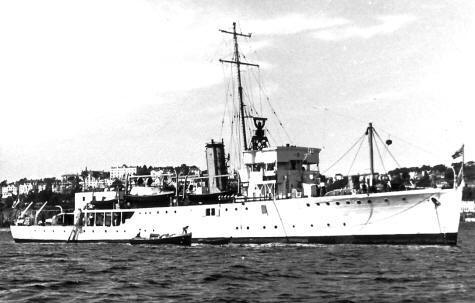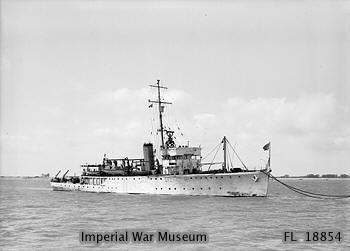











|
|

HMS Seagull after conversion to survey ship
|
27.11.45 |
Chatham |
Apr 46 |
Converting to Survey
Vessel |
|
22.4.46 |
Started trials |
Vice Admiral Sir Guy Wyatt had no sooner taken office as
Hydrographer than he was agitating to bring the surveying fleet up
to strength. As after the previous war, early replacements could not
be new vessels when there was a vast surplus of shipping, including
many nearly completed hulls, available. As an immediate measure two
Halcyon class minesweepers, Sharpshooter and SEAGULL, were given
similar conversions to those built into Jason and Gleaner pre‑war,
and replaced these latter in the post‑war surveying fleet. With
luffing davits and radar fitted, the mainmast which the other two
had carried and which had in any case been removed to avoid fouling
the AA arcs during the war was not replaced. Both were ready for
service in the new role by early 1946.
SEAGULL and Sharpshooter thus introduced the third variant in
surveying Halcyon masting, since though they, like their
predecessors, were fitted with a beaconing derrick and stump on the
forecastle and maintained their foremast aft of the bridge, they did
not have their mainmasts restored, so a Halcyon in surveying white
and buff without a mainmast must be one of these later two.
|
|
6.46 - 1951 |
Surveying Homes waters |

HMS Seagull (IWM FL18854)
|
|
|
HMS SEAGULL - Principal
Surveys |
|
Year |
Commander |
|
|
|
1946 |
K St B Collins |
England, West Coast.
Wales, West Coast.
Scotland, West Coast.
|
Liverpool Bay.
Milford Haven.
Islay to Inishtrahull. |
|
1947 |
K St B Collins |
England, West Coast.
Scotland, West Coast.
Ireland, North Coast. |
Bristol Channel entrance.
Kilbrannan Sound;
Gareloch.
N.W. Approaches to St
George’s Channel; Lough Foyle. |
|
1948 |
SJ Hennessey |
England, East Coast.
Bristol Channel |
Thames Estuary and
approaches.
Weston Super Mare to
Portishead. |
|
1949 |
C C Lowry |
Bristol Channel. |
Worms Head to Watchet;
Swansea Bay; Sker Point to Nash Point.; Barnstaple and Bideford. |
|
1950 |
D L Gordon |
England, South Coast |
Bolt Tail to Teignmouth;
Tor Bay. |
|
|
In an early use of electronic aids for surveying Collins in SEAGULL
in 1947 used constant radar ranges of a prominent object to control
his lines of soundings, meanwhile fixing his position along them by
sextant angles in the traditional way. In the strong tidal streams
and difficult waters off Northern Ireland this expedited sounding
quite considerably, and the method was promulgated in a Professional
Paper to the fleet.
|
|
1950 |
Having spent the 1950
season with a reduced crew mainly in Torbay, SEAGULL paid off that
autumn |
(In 1949) Seagull was employed in the Bristol Channel, mainly
sweeping for wrecks, of which there were plenty. Recreation and
replenishing was at Swansea, Cardiff and on one occasion,
Avonmouth.
In mid-December, the end of the surveying season, we returned to
Devonport for refit and chart draughting until March 1950.
The 1950 surveying season ( Seagull's last ) was spent surveying in
and around Torbay (Bolt Tail to Paignton). What a glorious finale!
Source: Tony Halson
|
|
1.3.51 |
To Category 'Z' Reserve at
Devonport - for disposal |
|
Became the
naval drill ship at Leith in 1955 ? |
|
Scrapped by
Demmelweek and Redding in Plymouth in 1956 |
|

